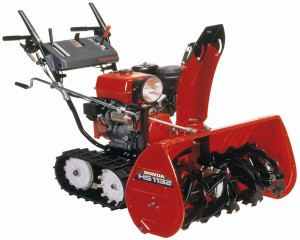 The biggest mistake a snowblower owner can make as the temperatures warm up is to simply allow their equipment to languish in the garage without proper maintenance prior to storage. This pre-storage maintenance is an absolutely essential way to minimize the kind of damage that can arise from improper cleaning and lubrication, and it helps to stave off engine problems, corrosion, spark plug defects, and many other common maintenance headaches that would otherwise be a major issue during the winter. Instead of ignoring the snowblower in favor of warm-weather tools, make sure an extensive maintenance checklist is checked off beforehand.
The biggest mistake a snowblower owner can make as the temperatures warm up is to simply allow their equipment to languish in the garage without proper maintenance prior to storage. This pre-storage maintenance is an absolutely essential way to minimize the kind of damage that can arise from improper cleaning and lubrication, and it helps to stave off engine problems, corrosion, spark plug defects, and many other common maintenance headaches that would otherwise be a major issue during the winter. Instead of ignoring the snowblower in favor of warm-weather tools, make sure an extensive maintenance checklist is checked off beforehand.
A Quick Safety Disclaimer About Maintenance and Potential Injuries
Engines can be hot, augers can be sharp, and the fumes from a snowblower can be toxic or deadly if operators aren’t careful during pre-storage maintenance. To avoid these literal and figurative headaches, equipment owners should make sure that all maintenance is done in a quiet, well-ventilated area free of pets and bystanders. All maintenance should be done after the engine has had time to cool down, and all fluids should be handled only when the engine is cool. By following these basic guidelines, virtually all of the hazards associated with snowblower maintenance can be effectively eliminated.
It’s Tine for Some Snowblower Storage Preparation
The time has finally come to put away winter’s tools and embrace the first warm days of spring. Before that can begin, however, the snowblower needs a final bit of preparation. Here’s what to know.
1. Cleaning and Lubrication
Snowblowers get pretty dirty during the winter, since they routinely deal with the combination of snow, mud, and road grime. Don’t store the snowblower with all of this residue still lingering after a long winter. Instead, use a mild dish detergent to wash off the snowblower’s exterior, discharge chute areas, and auger housing. This will prevent against unwanted damage, corrosion, and other long-term storage damage that might otherwise result.
To further reduce the likelihood of corrosion or other damage, make sure to lubricate the snowblower’s bearings, bolts, and any exposed or moving parts that might otherwise start to rust while the snowblower lingers in the garage for the next six months or so. A mild grease-based lubricant should be used during this process to ensure the best long-term results.
2. Fuel/Stabilizer
While some snowblower owners prefer to drain all remaining fuel, and some snowblower manufacturers even recommend that this be done prior to storage, the Honda HS1336i can actually be stored with a tank full of fuel. In order to store the snowblower, however, equipment owners will need to add a fuel stabilizer that helps to keep the gasoline “fresh” during its extended absence from everyday use.
To begin, simply fill the fuel tank with new gasoline that meets the recommended octane, ethanol, and methanol limits set out in the HS1336i’s user guide. Next, add the amount of fuel stabilizer recommended by the manufacturer. When the appropriate amount has been added, start the engine and allow it to run for up to 10 minutes. This ensures that the stabilizer has been appropriately mixed throughout the equipment.
3. Engine Oil
A quick look at the Honda snowblower’s maintenance guide will reveal a key recommendation: Oil must be changed each year prior to storage. To do this, remove the oil drain plug and fully drain any old oil into an approved, eco-friendly disposal container. Replace the drain plug and refill the oil compartment using Honda’s recommended 5W30 engine oil. Continue replacing the oil until it reaches the recommended fill line on the dipstick, and then replace the cap to keep the new lubricant contained.
4. Spark Plug
The spark plug can be come damaged over the course of a typical winter, so it’s important to remove it from the equipment and check it for any built-up carbon or dirt deposits, any problems with the terminals, or any other damage that might make it harder to start the snowblower next year. If the spark plug shows damage or signs of excessive wear, a replacement OEM Honda spark plug should be added to the shopping list. If not, the spark plug will likely last well into next winter. Even so, it should remain disconnected while the snowblower is in storage for safety reasons.
5. Battery
Prior to extended snowblower storage, the battery’s negative terminal should be disconnected and the batteries should be removed from the snowblower completely. Honda recommends giving these batteries a charge every 6 months and each year prior to using the snowblower for the first time. This will keep the batteries fresh and in top condition.
Get the OEM Parts Needed for Storage at HondaLawnParts.com
For all the parts and fluids needed prior to long-term storage, HondaLawnParts.com can help. Thanks to an online lookup tool, it’s never been easier to find the right OEM Honda parts based on equipment type, model number, engine maker, and the specific part number required for service.
